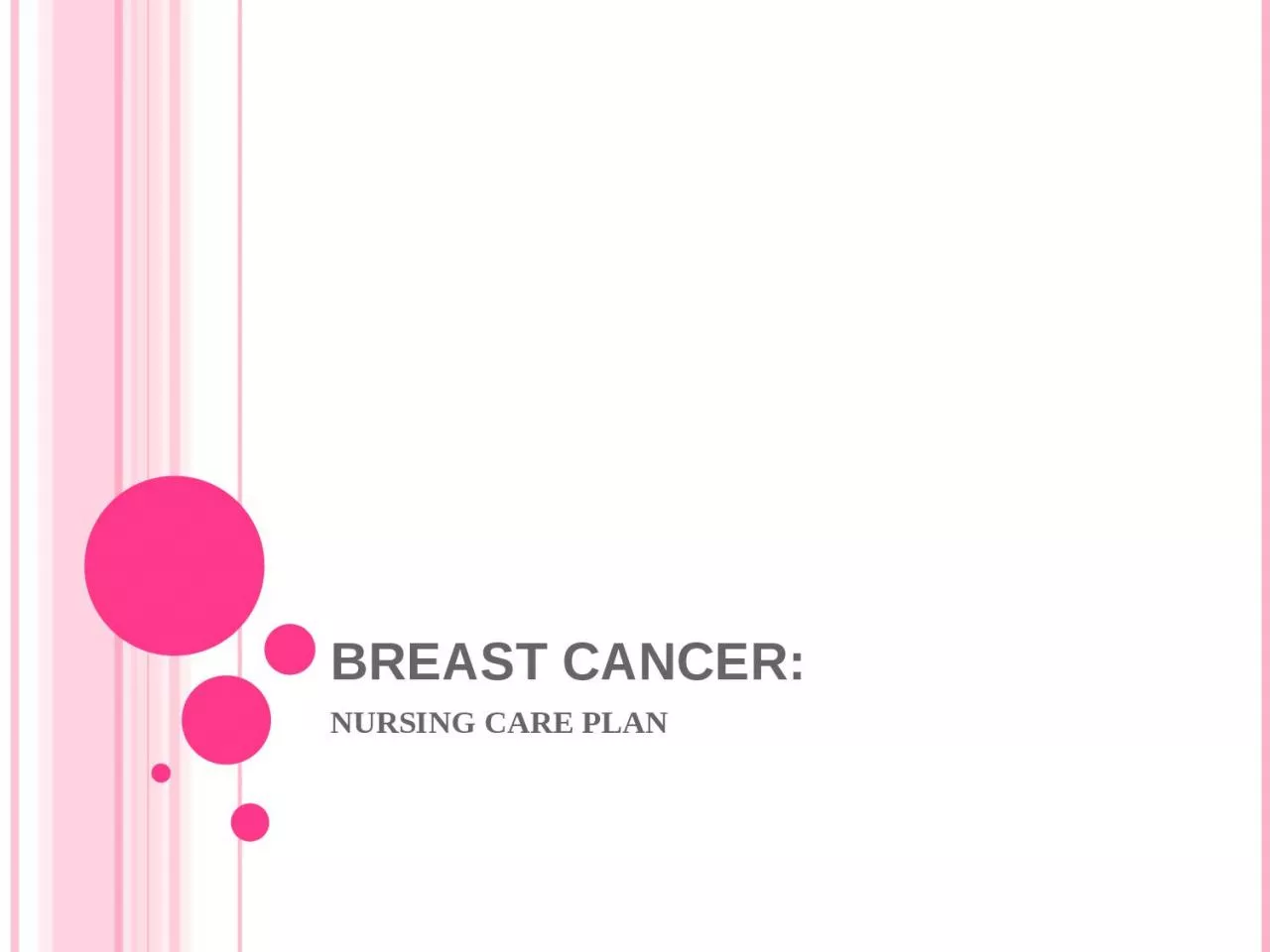

NURSING ASSESSMENT Risk Factors Personalfamily histories of breast cancer Age menarcheAge menopause early menses or late menopause increase risk Symptoms of menopause Age first childs birth ID: 1032199
Download Presentation The PPT/PDF document "BREAST CANCER: NURSING CARE PLAN" is the property of its rightful owner. Permission is granted to download and print the materials on this web site for personal, non-commercial use only, and to display it on your personal computer provided you do not modify the materials and that you retain all copyright notices contained in the materials. By downloading content from our website, you accept the terms of this agreement.
1. BREAST CANCER:NURSING CARE PLAN
2. NURSING ASSESSMENT:Risk FactorsPersonal/family histories of breast cancerAge @ menarche/Age @ menopause (early menses or late menopause increase risk)Symptoms of menopauseAge @ first child’s birthNumber of children (nulliparity/birth of first child after age 30 increase risk)
3. History of Breast MassReveals course of disease, health care-seeking practices. BSE or accidental discovery? Time interval between discovery and seeking health care providerReview of systems focusing on the most common areas of metastasesClient’s Health Maintenance PracticesKnowledge, practice and regularity of BSEMammographic historyDiet history (High alcohol, fat intake increase risk)Medications – hormone supplements, birth control pills
4. PHYSICAL ASSESSMENT:Focused Assessment of breast massShapeSizeConsistencyFixation to surrounding tissuesAny skin change (peau d’orange)Palpate axillary, superclavicular areas for enlarged lymph nodesPain, soreness?Diagram
5. A firm lump or thickness in breast, usually painless; 50% are located in the upper outer quadrant of the breast.Spontaneous nipple discharge; may be bloody, clear or serous.Asymmetry of the breast may be noted as the patient changes positions; compare one breast with the other.Nipple retraction or scalliness, especially in Paget’s disease.Enlargement of auxiliary or supraclavicular lymph nodes may indicate metastasis.
6. PSYCHOSOCIAL ASSESSMENT:Fear Threats to body image, intimate relationships and survivalDecisions regarding treatment optionsExplore client’s feelings, support system, client’s & family’s knowledgeClient’s level of educationSexuality – psychologic, physiologic, relationalEvaluate need for additional resources
7. NURSING DIAGNOSIS:Anxiety related to diagnosis of breast cancer Collaborative Problem: Potential for MetastasisAnticipatory Grieving r/t loss and possible or impending deathAcute Pain r/t tumour compression on nerve endingsDisturbed Sleep Pattern r/t pain and anxietyDisturbed Body Image r/t loss of a body partSexual Dysfunction r/t body image or self-esteem disturbance
8. NURSING OBJECTIVE:Expected OutcomesThe client will demonstrate the correct method of breast self-examination (BSE) and practice BSE on a monthly basisThe client will comply with the guidelines for mammography and professional examinationThe client will be able to cope with the diagnosis, as shown by her use of social support, use of information to deal with uncertainty, absence of physical signs of anxiety and verbal confirmation of feeling calmThe client will state that she feels positive about her self-imageThe client will regain full range of motion of the affected armThe client will remain free from lymphedema or infection
9. NURSING PLANNING:AnxietySeek information to reduce anxietyControl anxiety responsesUse effective coping strategies throughout the treatment periodParticipate in decision makingDiscuss concernsLearn self-care measuresPotential for MetastasisThe client with breast cancer is expected to remain free of metastases or recurrence of cancer
10. NURSING IMPLEMENTATION:AnxietyAnxiety Reduction:Allow the client to vent her feelings; listen attentivelyUse calm, reassuring approachProvide factual information concerning diagnosis, treatment and prognosisEncourage verbalization of feelings, perceptions and fearsIdentify when level of anxiety changesSupport the use of appropriate defense mechanismsDetermine client’s decision-making abilityFlexibility is the keySuggest support groups
11. Potential for MetastasisNonsurgical Management:Late-stage breast cancer; may be only treatment possible.Tumour removal with local anaesthetic or resectionF/U with hormonal therapy, chemotherapy, radiation
12. Surgical Management:Halsted radical mastectomy – breast tissue, nipple, underlying muscles, lymph nodes (rarely performed)Modified radical mastectomy – breast tissue, nipple, lymph nodesSimple mastectomy – breast tissue, nipple (lymph nodes left intact)Lumpectomy – only tumour , small amount of surrounding tissue removed
13. The nurse provides:Preoperative care – psychologic preparation, preoperative teaching; assess need for drainage tube, mobility restrictions, length of hospital stay, possibility of additional therapy; address body image issuesIntra-operative care – circulator, scrubPostoperative care – avoid using affected side for B/P, injections, blood draws; care of drainage tubes, comfort measures, client teaching, ambulation, adls, exercise,
14. Breast ReconstructionThe nurse:Assesses incision, flap sitesTeaches client to avoid pressure flap, suture linesCares for drainage devicesTeaches client to avoid sleeping in prone positionTeaches client to avoid contact sportsTeaches client to minimize pressure to breast during sexual relationsTeaches client to refrain from drivingReassures client that optimal appearance may not occur for 3-6 months post – surgeryReviews BSE procedureReminds client that mammograms should be scheduled at least yearly for the rest of her lifeRefers to ACSAssesses the client’s attitude toward appearance restoration
15. Adjuvant Therapy:F/U with radiation, chemotherapy, hormone therapy; stem cell therapy; bone marrow therapyThe nurse knows the specific agents to be used and their properties; provides care for client before, during, after procedures
16. Community-Based Care:Home Care ManagementHealth Teaching – teaching plan should include:Measures to optimize body imageInformation to enhance interpersonal relationshipsExercises to regain full ROMMeasures to prevent infection of incisionHealth Care Resources:The nurse makes referrals to community resources
17. NURSING INTERVENTION:Monitor for adverse effects of radiation therapy such as fatigue, sore throat, dry cough, nausea, anorexia.Monitor for adverse effects of chemotherapy; bone marrow suppression, nausea and vomiting, alopecia, weight gain or loss, fatigue, stomatitis, anxiety, and depression.Realize that a diagnosis of breast cancer is a devastating emotional shock to the woman. Provide psychological support to the patient throughout the diagnostic and treatment process.Involve the patient in planning and treatment.Describe surgical procedures to alleviate fear.
18. Prepare the patient for the effects of chemotherapy, and plan ahead for alopecia, fatigue.Administer antiemetics prophylactically, as directed, for patients receiving chemotherapy.Administer I.V. fluids and hyperalimentation as indicated.Help patient identify and use support persons or family or community.Suggest to the patient the psychological interventions may be necessary for anxiety, depression, or sexual problems.Teach the recommended cancer-screening procedures.
19. NURSING EVALUATION:The nurse evaluates the care of the client with breast cancer on the basis of the identified nursing diagnoses and collaborative problems.
20. THANK YOUBY: SRY INDAH WULAN SARI